A Comprehensive Transcriptomic and Proteomics Analysis of Candidate Secretory Proteins in Rose Grain Aphid, Metopolophium dirhodum (Walker)
Abstract
1. Introduction
2. Materials and Methods
2.1. Aphid Handling and RNA Preparation
2.2. cDNA Library Preparation, Cluster Generation and Sequencing
2.3. Quality Control, Transcriptome Assembly, and Gene Annotation
2.4. Prediction of Secretory Proteins
2.5. Saliva Collection, Extraction and Protein Identification
2.5.1. Saliva Collection and Extraction
2.5.2. Liquid Chromatography Tandem Mass Spectrometry (LC-MS/MS)
2.5.3. Proteomic Data Analysis and Similarity Search
3. Results
3.1. Functional Annotation of Gene Transcripts
3.2. Gene Ontology and Eukaryotic Orthologous Groups Classification (KOG)
3.3. Metabolic Pathway Analysis by Kyoto Encyclopedia of Genes and Genomes (KEGG)
3.4. Putative Secretory Proteins
3.5. Salivary Proteins and Sequence Similarity Among Aphid Species
4. Discussion
4.1. Putative Effectors
4.2. Detoxifying Secretory Proteins
4.3. Digestive Secretory Proteins
4.4. Ca2+ Binding Secretory Proteins
4.5. Zn-Binding Secretory Proteins
4.6. Reproduction and Development
4.7. Protein Synthesis and Secretion
4.8. Odorant Binding and Chemosensory Proteins
5. Conclusions and Recommendation
Supplementary Materials
Author Contributions
Funding
Institutional Review Board Statement
Informed Consent Statement
Data Availability Statement
Acknowledgments
Conflicts of Interest
References
- Gupta, V. Aphids on the world’s crops. An identification and information guide. Orient. Insects 2001, 35, 104. [Google Scholar] [CrossRef]
- International Aphid Genomics Consortium. Genome Sequence of the Pea Aphid Acyrthosiphon pisum. PLoS Biol. 2010, 8, e1000313. [Google Scholar] [CrossRef]
- Favret, C.; Normandin, É.; Cloutier, L. The Ouellet-Robert Entomological Collection: New electronic resources and perspectives. Can. Entomol. 2019, 151, 423–431. [Google Scholar] [CrossRef]
- Blackman, R.; Eastop, V. Aphids on the World Herbaceous Plants and Shrubs: An Identification and Information Guide; John Wiley & Sons Ltd.: Chichester, UK, 2006. [Google Scholar]
- Harmel, N.; Létocart, E.; Cherqui, A.; Giordanengo, P.; Mazzucchelli, G.; Guillonneau, F.; De Pauw, E.; Haubruge, E.; Francis, F. Identification of aphid salivary proteins: A proteomic investigation of Myzus persicae. Insect Mol. Biol. 2008, 17, 165–174. [Google Scholar] [CrossRef] [PubMed]
- Zhang, H.; Lin, R.; Liu, Q.; Lu, J.; Qiao, G.; Huang, X. Transcriptomic and proteomic analyses provide insights into host adaptation of a bamboo-feeding aphid. Front. Plant Sci. 2023, 13, 1098751. [Google Scholar] [CrossRef]
- Goggin, F.L. Plant–aphid interactions: Molecular and ecological perspectives. Curr. Opin. Plant Biol. 2007, 10, 399–408. [Google Scholar] [CrossRef]
- Carolan, J.C.; Caragea, D.; Reardon, K.T.; Mutti, N.S.; Dittmer, N.; Pappan, K.; Cui, F.; Castaneto, M.; Poulain, J.; Dossat, C. Predicted effector molecules in the salivary secretome of the pea aphid (Acyrthosiphon pisum): A dual transcriptomic/proteomic approach. J. Proteome Res. 2011, 10, 1505–1518. [Google Scholar] [CrossRef]
- Hogenhout, S.A.; Bos, J.I. Effector proteins that modulate plant--insect interactions. Curr. Opin. Plant Biol. 2011, 14, 422–428. [Google Scholar] [CrossRef]
- Guo, K.; Wang, W.; Luo, L.; Chen, J.; Guo, Y.; Cui, F. Characterization of an aphid-specific, cysteine-rich protein enriched in salivary glands. Biophys. Chem. 2014, 189, 25–32. [Google Scholar] [CrossRef]
- Wang, W.; Dai, H.; Zhang, Y.; Chandrasekar, R.; Luo, L.; Hiromasa, Y.; Sheng, C.; Peng, G.; Chen, S.; Tomich, J.M.; et al. Armet is an effector protein mediating aphid-plant interaction. FASEB J. 2015, 29, 2032–2045. [Google Scholar] [CrossRef]
- Wang, W.; Luo, L.; Lu, H.; Chen, S.; Kang, L.; Cui, F. Angiotensin-converting enzymes modulate aphid-plant interactions. Sci. Rep. 2015, 5, 8885. [Google Scholar] [CrossRef] [PubMed]
- Sharma, A.; Khan, A.; Subrahmanyam, S.; Raman, A.; Taylor, G.; Fletcher, M. Salivary proteins of plant-feeding hemipteroids–implication in phytophagy. Bull. Entomol. Res. 2014, 104, 117–136. [Google Scholar] [CrossRef] [PubMed]
- Atamian, H.S.; Chaudhary, R.; Cin, V.D.; Bao, E.; Girke, T.; Kaloshian, I. In planta expression or delivery of potato aphid Macrosiphum euphorbiae effectors Me10 and Me23 enhances aphid fecundity. Mol. Plant-Microbe Interact. 2013, 26, 67–74. [Google Scholar] [CrossRef]
- Bos, J.I.; Prince, D.; Pitino, M.; Maffei, M.E.; Win, J.; Hogenhout, S.A. A functional genomics approach identifies candidate effectors from the aphid species Myzus persicae (green peach aphid). PLoS Genet. 2010, 6, e1001216. [Google Scholar] [CrossRef]
- Elzinga, D.A.; De Vos, M.; Jander, G. Suppression of plant defenses by a Myzus persicae (green peach aphid) salivary effector protein. Mol. Plant-Microbe Interact. 2014, 27, 747–756. [Google Scholar] [CrossRef]
- Pitino, M.; Hogenhout, S.A. Aphid protein effectors promote aphid colonization in a plant species-specific manner. Mol. Plant-Microbe Interact. 2013, 26, 130–139. [Google Scholar] [CrossRef] [PubMed]
- Bos, J.I.; Armstrong, M.R.; Gilroy, E.M.; Boevink, P.C.; Hein, I.; Taylor, R.M.; Zhendong, T.; Engelhardt, S.; Vetukuri, R.R.; Harrower, B.; et al. Phytophthora infestans effector AVR3a is essential for virulence and manipulates plant immunity by stabilizing host E3 ligase CMPG1. Proc. Natl. Acad. Sci. USA 2010, 107, 9909–9914. [Google Scholar] [CrossRef]
- Moreno, A.; Garzo, E.; Fernandez-Mata, G.; Kassem, M.; Aranda, M.; Fereres, A. Aphids secrete watery saliva into plant tissues from the onset of stylet penetration. Entomol. Exp. Et Appl. 2011, 139, 145–153. [Google Scholar] [CrossRef]
- Will, T.; Tjallingii, W.F.; Thönnessen, A.; van Bel, A.J. Molecular sabotage of plant defense by aphid saliva. Proc. Natl. Acad. Sci. USA 2007, 104, 10536–10541. [Google Scholar] [CrossRef]
- Cock, P.J.; Grüning, B.A.; Paszkiewicz, K.; Pritchard, L. Galaxy tools and workflows for sequence analysis with applications in molecular plant pathology. PeerJ 2013, 1, e167. [Google Scholar] [CrossRef]
- Cooper, W.R.; Dillwith, J.W.; Puterka, G.J. Salivary proteins of Russian wheat aphid (Hemiptera: Aphididae). Environ. Entomol. 2010, 39, 223–231. [Google Scholar] [CrossRef] [PubMed]
- Grabherr, M.G.; Haas, B.J.; Yassour, M.; Levin, J.Z.; Thompson, D.A.; Amit, I.; Adiconis, X.; Fan, L.; Raychowdhury, R.; Zeng, Q.; et al. Full-length transcriptome assembly from RNA-Seq data without a reference genome. Nat. Biotechnol. 2011, 29, 644–652. [Google Scholar] [CrossRef]
- Mao, X.; Cai, T.; Olyarchuk, J.G.; Wei, L. Automated genome annotation and pathway identification using the KEGG Orthology (KO) as a controlled vocabulary. Bioinformatics 2005, 21, 3787–3793. [Google Scholar] [CrossRef]
- Nie, L.; Wu, G.; Zhang, W. Correlation between mRNA and protein abundance in Desulfovibrio vulgaris: A multiple regression to identify sources of variations. Biochem. Biophys. Res. Commun. 2006, 339, 603–610. [Google Scholar] [CrossRef] [PubMed]
- Huang, H.J.; Wang, Y.Z.; Li, L.L.; Lu, H.B.; Lu, J.B.; Wang, X.; Ye, Z.X.; Zhang, Z.L.; He, Y.J.; Lu, G.; et al. Planthopper salivary sheath protein LsSP1 contributes to manipulation of rice plant defenses. Nat. Commun. 2023, 14, 737. [Google Scholar] [CrossRef] [PubMed]
- Kunieda, T.; Fujiyuki, T.; Kucharski, R.; Foret, S.; Ament, S.; Toth, A.; Ohashi, K.; Takeuchi, H.; Kamikouchi, A.; Kage, E. Carbohydrate metabolism genes and pathways in insects: Insights from the honey bee genome. Insect Mol. Biol. 2006, 15, 563–576. [Google Scholar] [CrossRef]
- Rao, S.A.; Carolan, J.C.; Wilkinson, T.L. Proteomic profiling of cereal aphid saliva reveals both ubiquitous and adaptive secreted proteins. PLoS ONE 2013, 8, e57413. [Google Scholar] [CrossRef]
- Chaudhary, R.; Atamian, H.S.; Shen, Z.; Briggs, S.P.; Kaloshian, I. Potato aphid salivary proteome: Enhanced salivation using resorcinol and identification of aphid phosphoproteins. J. Proteome Res. 2015, 14, 1762–1778. [Google Scholar] [CrossRef]
- Tokuda, G.; Saito, H.; Watanabe, H. A digestive β-glucosidase from the salivary glands of the termite, Neotermes koshunensis (Shiraki): Distribution, characterization and isolation of its precursor cDNA by 5′-and 3′-RACE amplifications with degenerate primers. Insect Biochem. Mol. Biol. 2002, 32, 1681–1689. [Google Scholar] [CrossRef]
- Wang, X.; Zhou, G.; Xiang, C.; Du, M.; Cheng, J.; Liu, S.; Lou, Y. β-Glucosidase treatment and infestation by the rice brown planthopper Nilaparvata lugens elicit similar signaling pathways in rice plants. Chin. Sci. Bull. 2008, 53, 53–57. [Google Scholar] [CrossRef]
- Zhang, Y.; Fu, Y.; Francis, F.; Liu, X.; Chen, J. Insight into watery saliva proteomes of the grain aphid, Sitobion avenae. Arch. Insect Biochem. Physiol. 2021, 106, e21752. [Google Scholar] [CrossRef] [PubMed]
- Pavithran, S.; Murugan, M.; Mannu, J.; Yogendra, K.; Balasubramani, V.; Sanivarapu, H.; Harish, S.; Natesan, S. Identification of salivary proteins of the cowpea aphid Aphis craccivora by transcriptome and LC-MS/MS analyses. Insect Biochem. Mol. Biol. 2024, 165, 104060. [Google Scholar] [CrossRef] [PubMed]
- Borrelli, G.M.; Trono, D. Recombinant lipases and phospholipases and their use as biocatalysts for industrial applications. Int. J. Mol. Sci. 2015, 16, 20774–20840. [Google Scholar] [CrossRef] [PubMed]
- Bargmann, B.O.; Munnik, T. The role of phospholipase D in plant stress responses. Curr. Opin. Plant Biol. 2006, 9, 515–522. [Google Scholar] [CrossRef]
- Young, S.A.; Wang, X.; Leach, J.E. Changes in the plasma membrane distribution of rice phospholipase D during resistant interactions with Xanthomonas oryzae pv oryzae. Plant Cell 1996, 8, 1079–1090. [Google Scholar] [CrossRef]
- Grennan, A.K. The role of trehalose biosynthesis in plants. Plant Physiol. 2007, 144, 3–5. [Google Scholar] [CrossRef]
- Almeida, A.M.; Villalobos, E.; Araújo, S.S.; Leyman, B.; Van Dijck, P.; Alfaro-Cardoso, L.; Fevereiro, P.S.; Torné, J.M.; Santos, D.M. Transformation of tobacco with an Arabidopsis thaliana gene involved in trehalose biosynthesis increases tolerance to several abiotic stresses. Euphytica 2005, 146, 165–176. [Google Scholar] [CrossRef]
- Iordachescu, M.; Imai, R. Trehalose biosynthesis in response to abiotic stresses. J. Integr. Plant Biol. 2008, 50, 1223–1229. [Google Scholar] [CrossRef]
- Su, Y.L.; Li, J.M.; Li, M.; Luan, J.B.; Ye, X.D.; Wang, X.W.; Liu, S.S. Transcriptomic analysis of the salivary glands of an invasive whitefly. PLoS ONE 2012, 7, e39303. [Google Scholar] [CrossRef]
- Zhang, Y.; Fan, J.; Sun, J.; Francis, F.; Chen, J. Transcriptome analysis of the salivary glands of the grain aphid, Sitobion avenae. Sci. Rep. 2017, 7, 15911. [Google Scholar] [CrossRef]
- Hayashi, H.; Chino, M. Collection of pure phloem sap from wheat and its chemical composition. Plant Cell Physiol. 1986, 27, 1387–1393. [Google Scholar] [CrossRef]
- Field, L.M.; Devonshire, A.L. Evidence that the E4 and FE4 esterase genes responsible for insecticide resistance in the aphid Myzus persicae (Sulzer) are part of a gene family. Biochem. J. 1998, 330 Pt. 1, 169–173. [Google Scholar] [CrossRef]
- BK, S.K.; Moural, T.; Zhu, F. Functional and structural diversity of insect glutathione S-transferases in xenobiotic adaptation. Int. J. Biol. Sci. 2022, 18, 5713. [Google Scholar]
- Vandermoten, S.; Harmel, N.; Mazzucchelli, G.; De Pauw, E.; Haubruge, E.; Francis, F. Comparative analyses of salivary proteins from three aphid species. Insect Mol. Biol. 2014, 23, 67–77. [Google Scholar] [CrossRef] [PubMed]
- Chen, M.-S.; Zhao, H.-X.; Zhu, Y.C.; Scheffler, B.; Liu, X.; Liu, X.; Hulbert, S.; Stuart, J.J. Analysis of transcripts and proteins expressed in the salivary glands of Hessian fly (Mayetiola destructor) larvae. J. Insect Physiol. 2008, 54, 1–16. [Google Scholar] [CrossRef] [PubMed]
- Belghazi, M. Extracellular superoxide dismutase in insects: Characterization, function and interspecific variation in parasitoid wasps’ venom. J. Biol. Chem. 2011, 286, 40110–40121. [Google Scholar]
- Shao, E.; Song, Y.; Wang, Y.; Liao, Y.; Luo, Y.; Liu, S.; Guan, X.; Huang, Z. Transcriptomic and proteomic analysis of putative digestive proteases in the salivary gland and gut of Empoasca (Matsumurasca) onukii Matsuda. BMC Genom. 2021, 22, 1–17. [Google Scholar] [CrossRef]
- Conte, E.; Dinoi, G.; Imbrici, P.; De Luca, A.; Liantonio, A. Sarcoplasmic reticulum Ca2+ buffer proteins: A focus on the yet-to-Be-explored role of sarcalumenin in skeletal muscle health and disease. Cells 2023, 12, 715. [Google Scholar] [CrossRef]
- Xue, W.; Fan, J.; Zhang, Y.; Xu, Q.; Han, Z.; Sun, J.; Chen, J. Identification and expression analysis of candidate odorant-binding protein and chemosensory protein genes by antennal transcriptome of Sitobion avenae. PLoS ONE 2016, 11, e0161839. [Google Scholar] [CrossRef]
- Carolan, J.C.; Fitzroy, C.I.; Ashton, P.D.; Douglas, A.E.; Wilkinson, T.L. The secreted salivary proteome of the pea aphid Acyrthosiphon pisum characterised by mass spectrometry. Proteomics 2009, 9, 2457–2467. [Google Scholar] [CrossRef]
- Jakhar, R.; Gakhar, S. Study and comparison of mosquito (Diptera) aminopeptidase N protein with other order of insects. Int. J. Mosq. Res. 2019, 6, 57–62. [Google Scholar]
- Cabot, C.; Martos, S.; Llugany, M.; Gallego, B.; Tolrà, R.; Poschenrieder, C. A role for zinc in plant defense against pathogens and herbivores. Front. Plant Sci. 2019, 10, 448458. [Google Scholar] [CrossRef] [PubMed]
- Upadhyay, S.K.; Singh, H.; Dixit, S.; Mendu, V.; Verma, P.C. Molecular characterization of vitellogenin and vitellogenin receptor of Bemisia tabaci. PLoS ONE 2016, 11, e0155306. [Google Scholar] [CrossRef]
- Wileman, H.J.; Perry, R.N.; Davies, K.G. Comparative phylogenetic analysis of vitellogenin in species of cyst and root-knot nematodes. Nematology 2023, 25, 467–476. [Google Scholar] [CrossRef]
- Brown, H.E.; Reichert, M.C.; Evans, T.A. In vivo functional analysis of drosophila Robo1 fibronectin type-III repeats. G3 Genes Genomes Genet. 2018, 8, 621–630. [Google Scholar] [CrossRef]
- Fu, J.; Shi, Y.; Wang, L.; Zhang, H.; Li, J.; Fang, J.; Ji, R. Planthopper-Secreted Salivary Disulfide Isomerase Activates Immune Responses in Plants. Front. Plant Sci. 2020, 11, 622513. [Google Scholar] [CrossRef] [PubMed]
- Darby, N.J.; Penka, E.; Vincentelli, R. The multi-domain structure of protein disulfide isomerase is essential for high catalytic efficiency. J. Mol. Biol. 1998, 276, 239–247. [Google Scholar] [CrossRef]
- Schönbrunner, E.R.; Mayer, S.; Tropschug, M.; Fischer, G.; Takahashi, N.; Schmid, F.X. Catalysis of protein folding by cyclophilins from different species. J. Biol. Chem. 1991, 266, 3630–3635. [Google Scholar] [CrossRef]
- Shih, P.Y.; Sugio, A.; Simon, J.C. Molecular Mechanisms Underlying Host Plant Specificity in Aphids. Annu. Rev. Entomol. 2023, 68, 431–450. [Google Scholar] [CrossRef]
- Thorpe, P.; Cock, P.J.; Bos, J. Comparative transcriptomics and proteomics of three different aphid species identifies core and diverse effector sets. BMC Genom. 2016, 17, 1–18. [Google Scholar] [CrossRef]
- Missbach, C.; Vogel, H.; Hansson, B.S.; Groβe-Wilde, E. Identification of odorant binding proteins and chemosensory proteins in antennal transcriptomes of the jumping bristletail Lepismachilis y-signata and the firebrat Thermobia domestica: Evidence for an independent OBP–OR origin. Chem. Senses 2015, 40, 615–626. [Google Scholar] [CrossRef] [PubMed]
- Dippel, S.; Oberhofer, G.; Kahnt, J.; Gerischer, L.; Opitz, L.; Schachtner, J.; Stanke, M.; Schütz, S.; Wimmer, E.A.; Angeli, S. Tissue-specific transcriptomics, chromosomal localization, and phylogeny of chemosensory and odorant binding proteins from the red flour beetle Tribolium castaneum reveal subgroup specificities for olfaction or more general functions. BMC Genom. 2014, 15, 1–14. [Google Scholar] [CrossRef] [PubMed]
- Stathopoulos, A.; Van Drenth, M.; Erives, A.; Markstein, M.; Levine, M. Whole-genome analysis of dorsal-ventral patterning in the Drosophila embryo. Cell 2002, 111, 687–701. [Google Scholar] [CrossRef] [PubMed]
- Rodriguez, P.A.; Stam, R.; Warbroek, T.; Bos, J.I. Mp10 and Mp42 from the aphid species Myzus persicae trigger plant defenses in Nicotiana benthamiana through different activities. Mol. Plant-Microbe Interact. 2014, 27, 30–39. [Google Scholar] [CrossRef]
- Jia, C.; Mohamed, A.; Cattaneo, A.M.; Huang, X.; Keyhani, N.O.; Gu, M.; Zang, L.; Zhang, W. Odorant-binding proteins and chemosensory proteins in Spodoptera frugiperda: From genome-wide identification and developmental stage-related expression analysis to the perception of host plant odors, sex pheromones, and insecticides. Int. J. Mol. Sci. 2023, 24, 5595. [Google Scholar] [CrossRef]
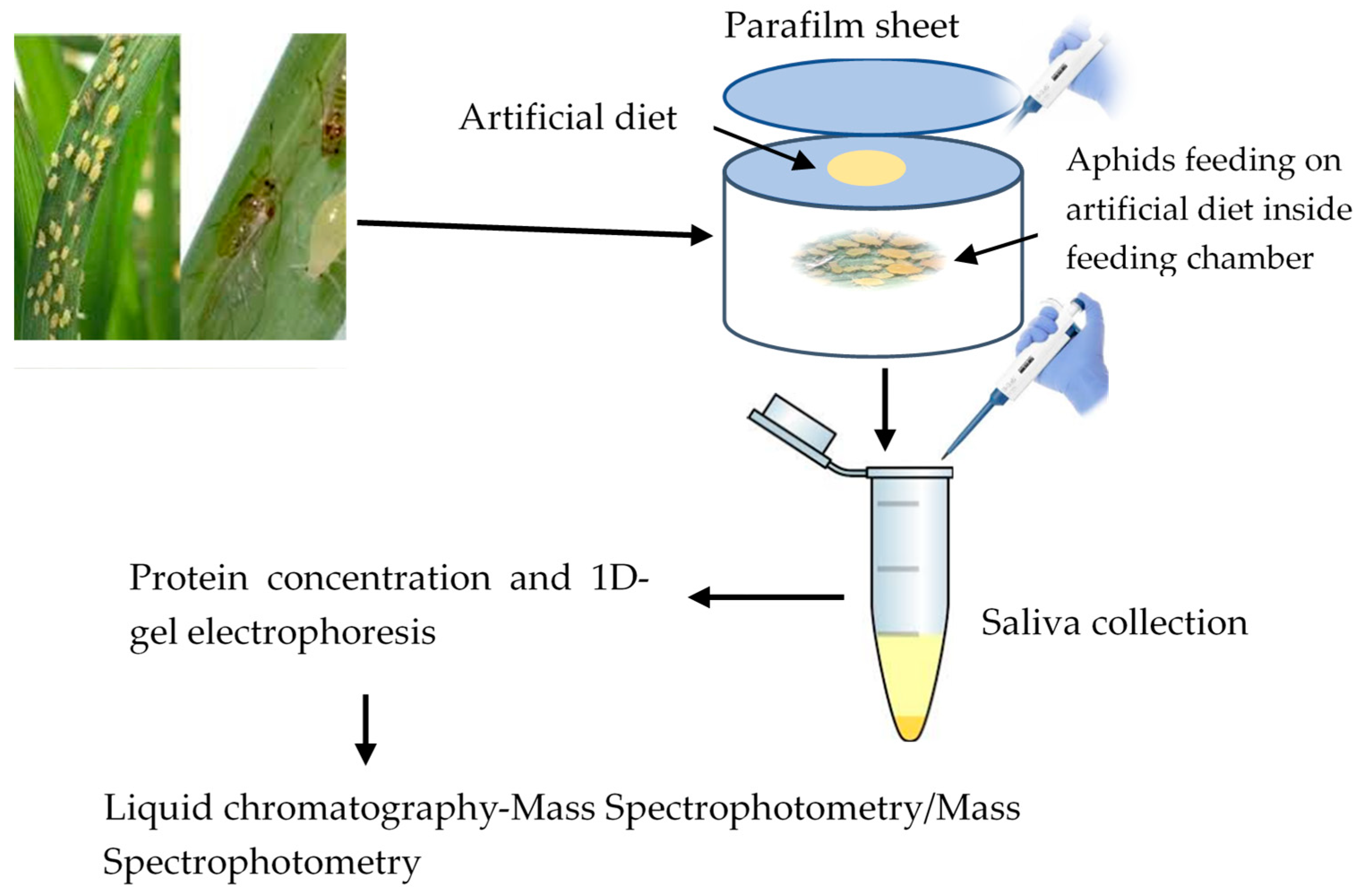

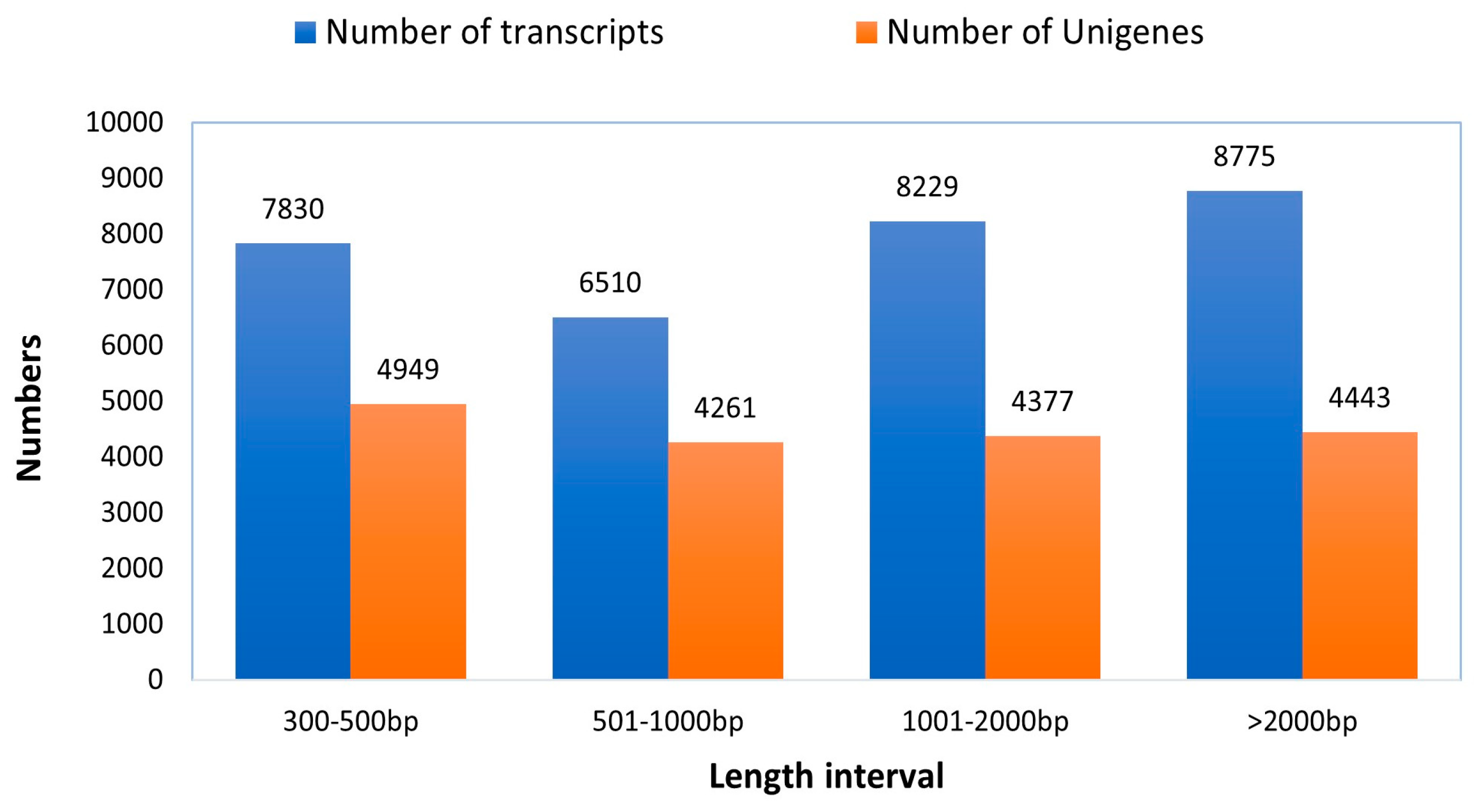
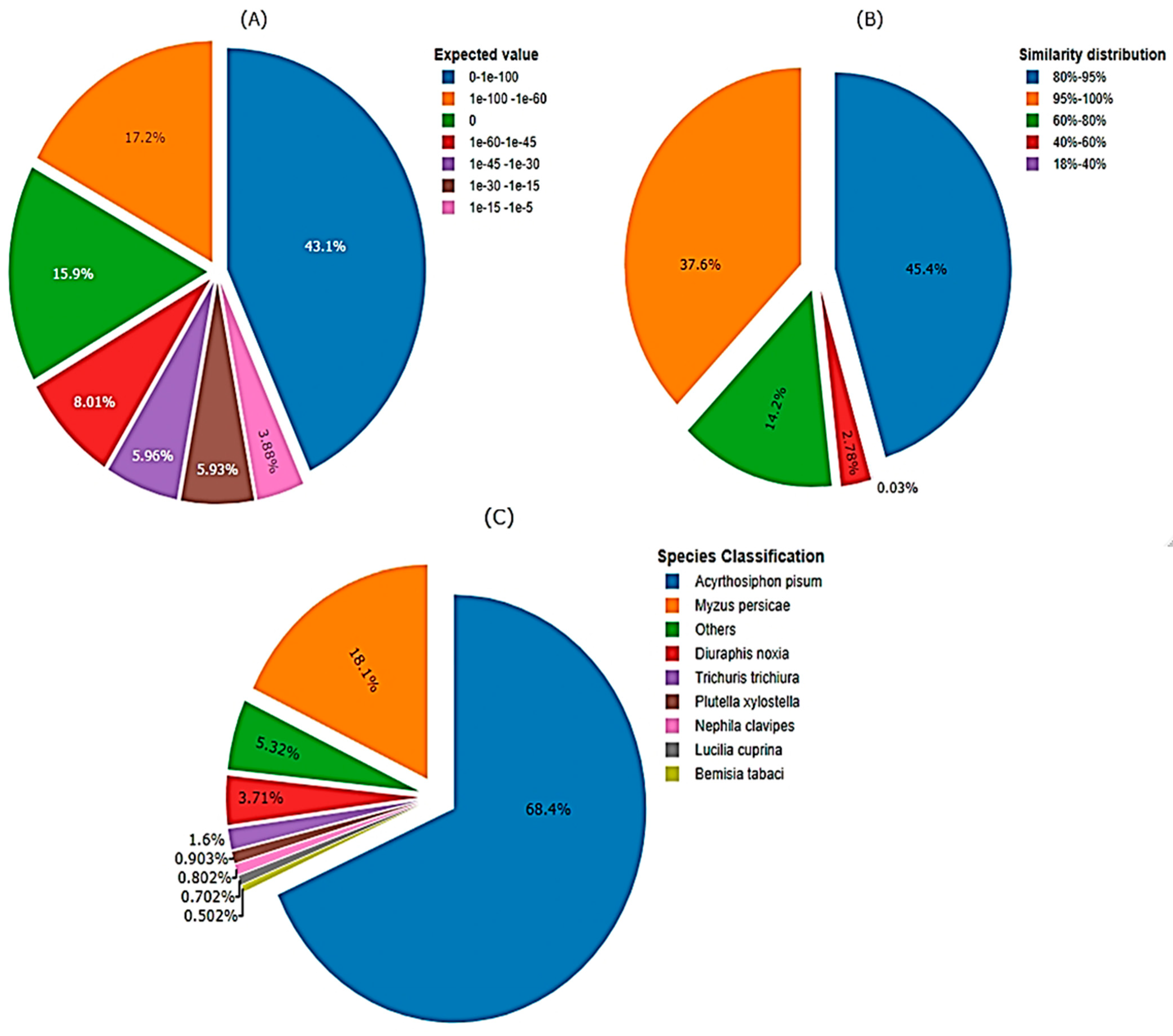
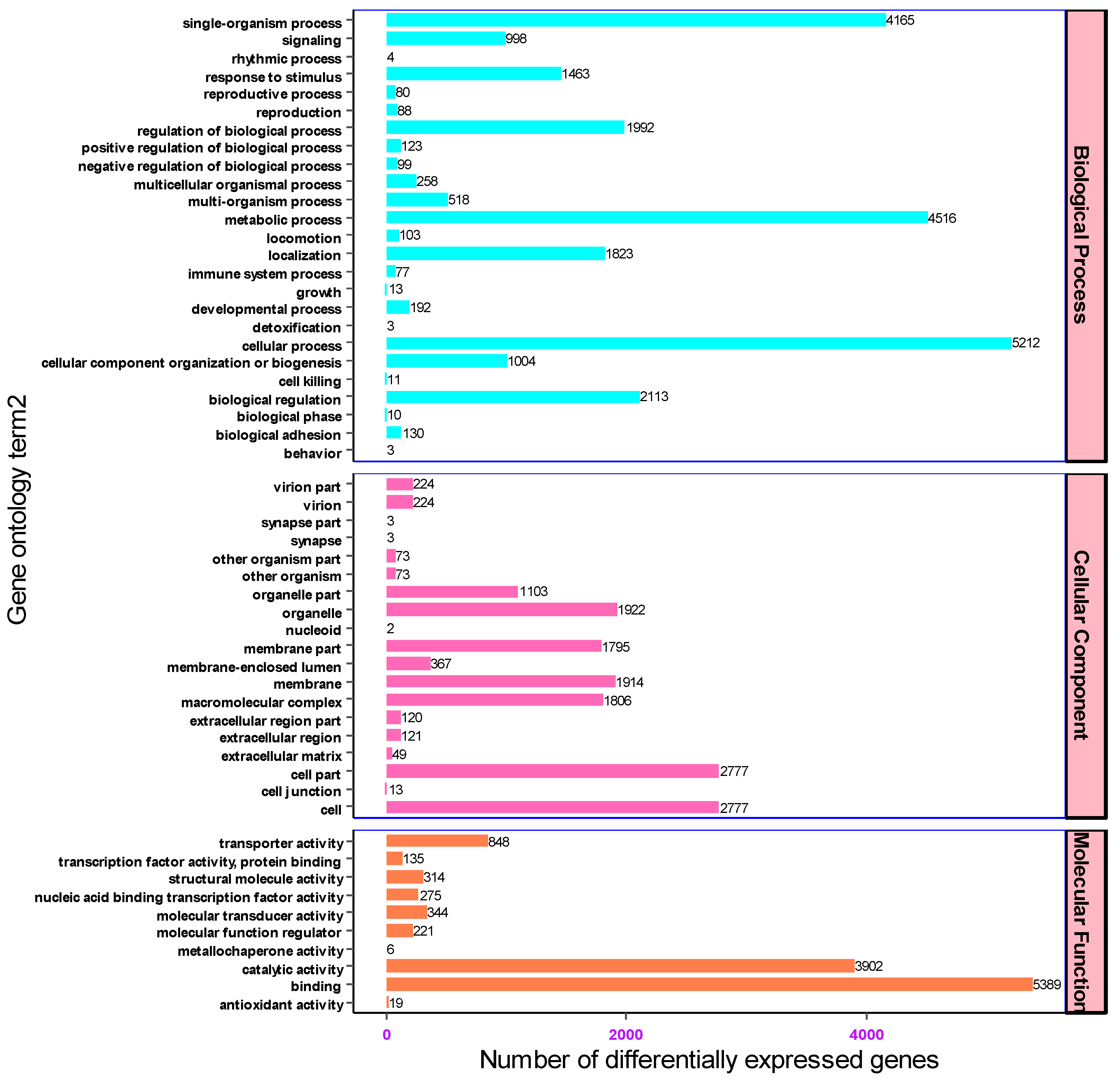
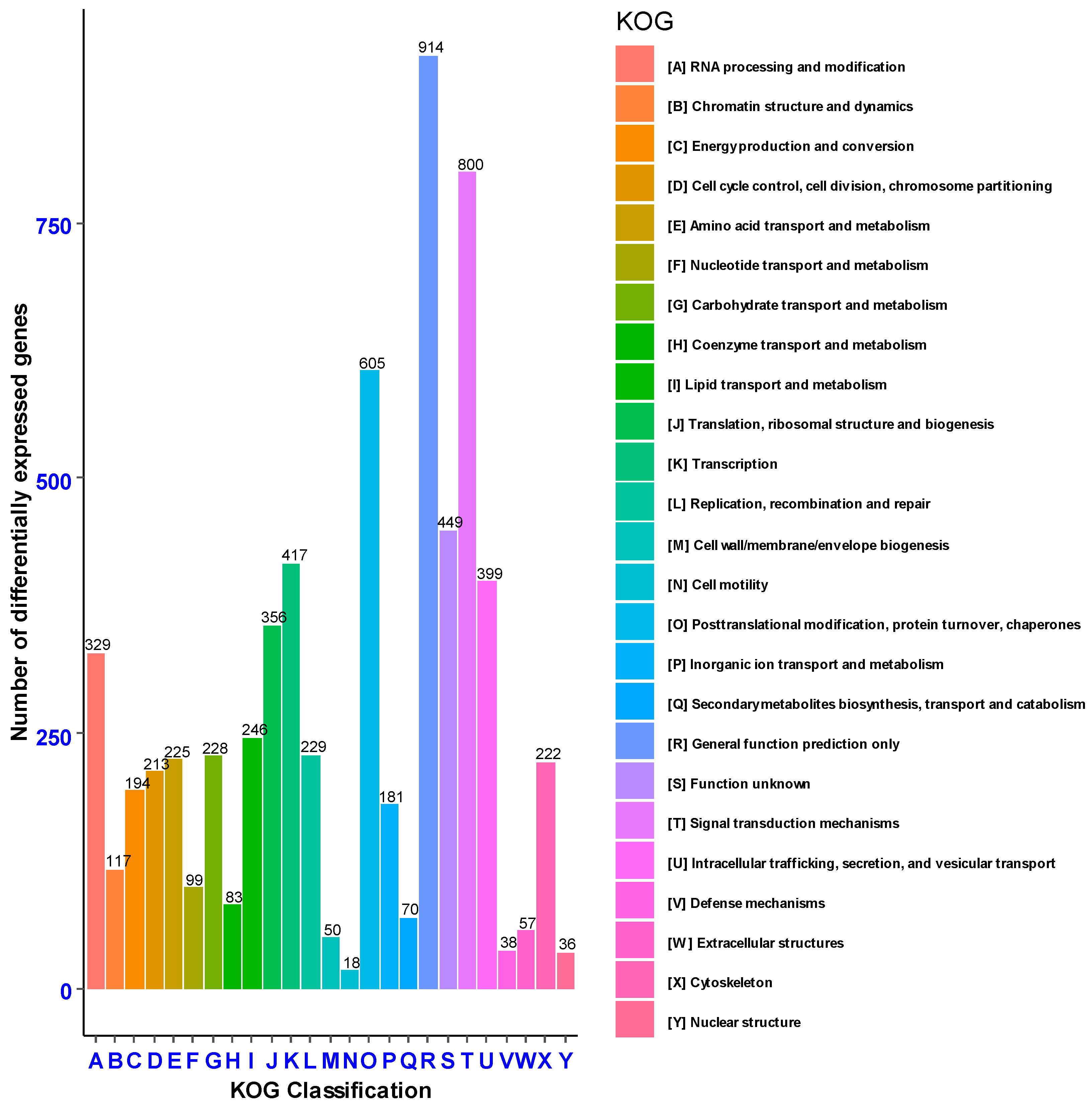
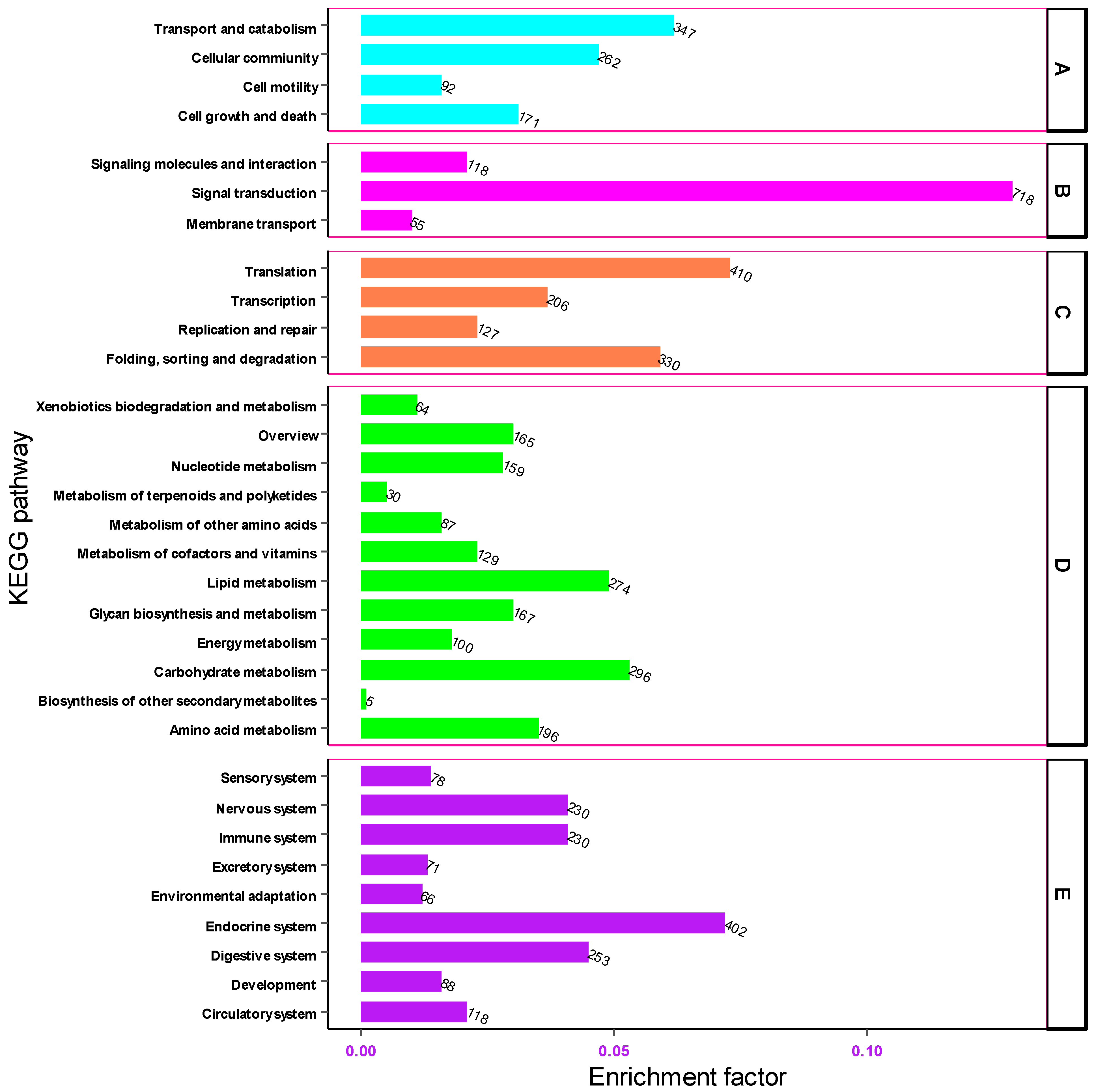
| S/N | Statistic | Read |
|---|---|---|
| 1 | Raw Reads (bp) | 47,565,328 |
| 2 | Clean Reads (bp) | 46,238,772 |
| 3 | Clean Bases (Gb) | 6.94 Gb |
| 4 | Error (%) | 0.03 |
| 5 | Q20 (%) | 97.61 |
| 6 | Q30 (%) | 93.04 |
| 7 | N percentage (%) | 0 |
| 8 | Total length of transcripts | 48,023,560 |
| 9 | Total length of genes | 25,480,502 |
| 10 | Number of Transcripts | 31,344 |
| 11 | Number of genes | 18,030 |
| 12 | Mean Length of Transcript | 1532 |
| 13 | Mean Length of gene | 1413 |
| 14 | N50 Transcript | 2335 |
| 15 | N50 Genes | 2205 |
| 16 | GC Content (%) | 42.47 |
| S/N | Data Base | Number of Genes | Percentage of Genes (%) |
|---|---|---|---|
| 1 | Nr | 12,589 | 69.82 |
| 2 | Nt | 14,253 | 79.05 |
| 3 | KO | 5587 | 30.98 |
| 4 | Swiss-Prot | 9467 | 52.5 |
| 5 | Pfam | 9314 | 51.65 |
| 6 | GO | 9314 | 51.65 |
| 7 | KOG | 5850 | 32.44 |
| 8 | All data bases | 3670 | 20.35 |
| 9 | At least one data base | 14,887 | 82.56 |
| 10 | Total Genes | 18,030 | 100 |
| Proteins Identified in the Saliva of M. dirhodum | Entry | Secretory Nature | Similarity Level | |||
|---|---|---|---|---|---|---|
| Yes | No | 100% | 90% | 50% | ||
| Actin related protein 1 isoform X1 | A0A6G0YHT2 | √ | 182 | 190 | 4066 | |
| ATP synthase subunit alpha, mitochondrial | A0A6G0YU19 | √ | 1 | 1 | 10 | |
| Elongation factor 1-alpha | A0A2H8TTF1 | √ | 13 | 373 | 1691 | |
| Glucose dehydrogenase like-protein 1 | K0DCK7 | √ | x | 2 | 2 | |
| Glucose dehydrogenase like-protein 2 | K0D9J0 | √ | x | x | 2 | |
| Heat shock protein 83 | A0A8R2AZJ4 | √ | 1 | 14 | 449 | |
| Heat shock protein 70KD | A0A5E4MRQ3 | √ | √ | 2 | 16 | 386 |
| Histone H2B | A0A2S2N8A9 | √ | 1 | 1 | 175 | |
| Histone H4 (Fragment) | A0A6G0XR79 | √ | 30 | 30 | 32 | |
| Peroxiredoxin 1 | A0A2S2NYR8 | √ | 1 | 1 | 17 | |
| Putative sheath protein (Fragment) | K0D9J4 | √ | x | x | 2 | |
| Tubulin beta chain | A0A6G0ZHT7 | √ | 6 | 53 | 133 | |
| Uncharacterized protein | A0A8R2NN35 | √ | 1 | 8 | 14 | |
| Vitellogenin domain-containing protein | A0A8R2F8V9 | √ | 1 | 1 | 9 | |
| HSC70b (Fragment) | V5KS27 | √ | 1 | 1 | 1 | |
| Protein Names Identified from the Saliva of M. dirhodum | Accession Number | Pulse Crop Aphids | Cereal Crop Aphids | ||||||||
|---|---|---|---|---|---|---|---|---|---|---|---|
| A. craccivora | A. glycines | A. pisum | A. gossypii | S. graminum | S. avenae | R. padi | M. persicae | M. sacchari | Sipha flava | ||
| Actin related protein 1 isoform X1 | A0A6G0YHT2 | √ | √ | √ | √ | x | √ | √ | x | √ | √ |
| ATP synthase subunit alpha, mitochondrial | A0A6G0YU19 | √ | x | x | x | x | x | x | x | x | x |
| Elongation factor 1-alpha | A0A2H8TTF1 | x | x | x | x | √ | x | x | x | √ | x |
| Glucose dehydrogenase like-protein 1 | K0DCK7 | x | x | x | x | x | √ | x | x | x | x |
| Glucose dehydrogenase like-protein 2 | K0D9J0 | x | x | x | x | x | √ | x | x | x | x |
| Heat shock protein 83 | A0A8R2AZJ4 | √ | √ | √ | √ | x | x | √ | √ | √ | √ |
| Heat shock protein 70KD | A0A5E4MRQ3 | √ | √ | √ | √ | x | x | √ | √ | √ | √ |
| Histone H2B | A0A2S2N8A9 | √ | √ | x | x | √ | x | x | x | x | x |
| Histone H4 (Fragment) | A0A6G0XR79 | √ | x | x | x | x | x | x | x | x | x |
| Peroxiredoxin 1 | A0A2S2NYR8 | x | x | x | x | √ | x | x | x | x | √ |
| Putative sheath protein | K0D9J4 | x | x | x | x | x | √ | x | x | x | x |
| Tubulin beta chain | A0A6G0ZHT7 | √ | √ | x | √ | x | x | x | x | √ | √ |
| Uncharacterized protein | A0A8R2NN35 | √ | √ | √ | √ | √ | x | x | x | √ | √ |
| Vitellogenin domain-containing protein | A0A8R2F8V9 | √ | √ | √ | √ | x | x | x | x | √ | √ |
| HSC70b (Fragment) | V5KS27 | x | x | x | x | x | √ | x | x | x | x |
| 9 | 7 | 5 | 6 | 4 | 5 | 3 | 2 | 7 | 7 | ||
Disclaimer/Publisher’s Note: The statements, opinions and data contained in all publications are solely those of the individual author(s) and contributor(s) and not of MDPI and/or the editor(s). MDPI and/or the editor(s) disclaim responsibility for any injury to people or property resulting from any ideas, methods, instructions or products referred to in the content. |
© 2024 by the authors. Licensee MDPI, Basel, Switzerland. This article is an open access article distributed under the terms and conditions of the Creative Commons Attribution (CC BY) license (https://creativecommons.org/licenses/by/4.0/).
Share and Cite
Gebrekidan, A.G.; Zhang, Y.; Chen, J. A Comprehensive Transcriptomic and Proteomics Analysis of Candidate Secretory Proteins in Rose Grain Aphid, Metopolophium dirhodum (Walker). Curr. Issues Mol. Biol. 2024, 46, 13383-13404. https://doi.org/10.3390/cimb46120798
Gebrekidan AG, Zhang Y, Chen J. A Comprehensive Transcriptomic and Proteomics Analysis of Candidate Secretory Proteins in Rose Grain Aphid, Metopolophium dirhodum (Walker). Current Issues in Molecular Biology. 2024; 46(12):13383-13404. https://doi.org/10.3390/cimb46120798
Chicago/Turabian StyleGebrekidan, Atsbha Gebreslasie, Yong Zhang, and Julian Chen. 2024. "A Comprehensive Transcriptomic and Proteomics Analysis of Candidate Secretory Proteins in Rose Grain Aphid, Metopolophium dirhodum (Walker)" Current Issues in Molecular Biology 46, no. 12: 13383-13404. https://doi.org/10.3390/cimb46120798
APA StyleGebrekidan, A. G., Zhang, Y., & Chen, J. (2024). A Comprehensive Transcriptomic and Proteomics Analysis of Candidate Secretory Proteins in Rose Grain Aphid, Metopolophium dirhodum (Walker). Current Issues in Molecular Biology, 46(12), 13383-13404. https://doi.org/10.3390/cimb46120798


_Kim.png)





